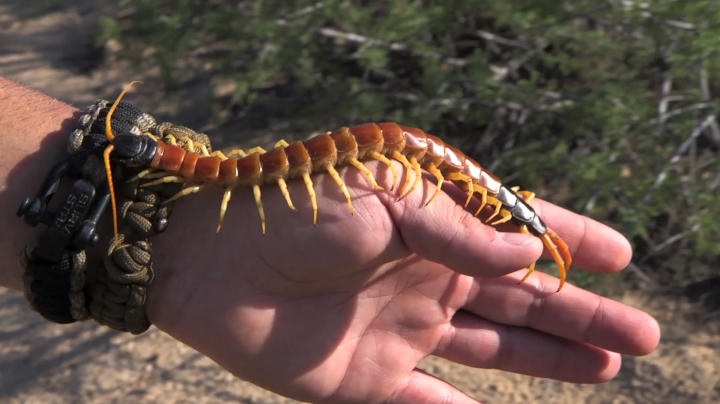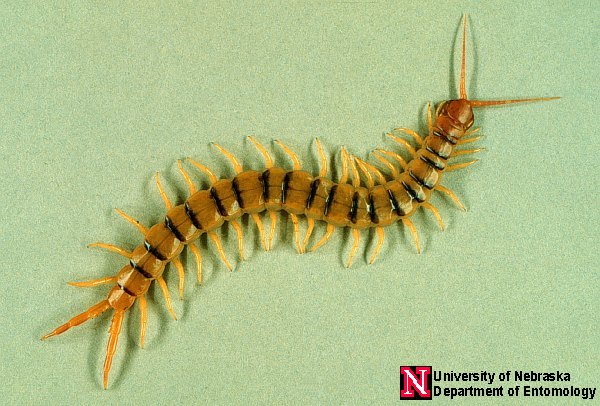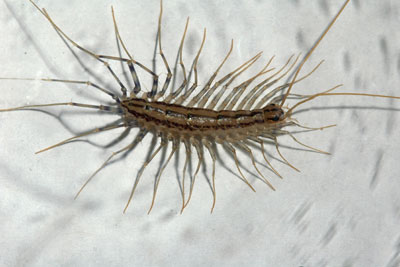Centipedes - May 3, 2017 Jeff Schalau, Agent, Agriculture & Natural Resources University of Arizona Cooperative Extension, Yavapai County Centipedes are not actually insects, but are in the same Phylum called “arthropods” which also includes insects, spiders, and crustaceans. They are not harmful to food, clothes, furniture, or other items within homes, although their presence can be unnerving. They are beneficial, predatory members of our local ecosystems and this column should help you understand their predatory role in local ecosystems. Centipedes are sometimes confused with millipedes but can be differentiated by the number of legs per body segment. Centipedes have only one pair of legs per segment while millipedes can have two or four pairs of legs per segment. Yavapai County Cooperative Extension receives several calls per year about centipedes. Three species of centipedes are common in north central Arizona. Centipedes are often reported to be vicious and almost a foot long. In truth, they are not vicious (unless they are being harassed). However, one species is often 6 inches in length (they can reach 8˝ inches). This large species is the giant desert centipede (Scolopendra heros) which occurs across much of Arizona and the southwest. The common desert centipede (Scolopendra polymorpha) is also reported to be present in our area, but I have not seen one in my 20 years here. The giant desert centipede is often colored reddish-yellow with darker bluish-black stripes running horizontally across where each body segment joins the next. The head is usually red-orange with antennae and the last segment has a pair of legs is often mistaken for “stingers”. These are actually prehensile legs that the centipede uses for grasping objects or seizing its prey. On the first segment behind the head, the centipede has hollow tubes, with openings at their sharpened tips that function as fangs. They are attached to venom glands, and are used to kill prey. These fangs are sharp and could potentially penetrate leather gloves. The centipede's bite is considered about as serious as a bee sting, but the risk of secondary infection from other pathogens is an additional risk factor to consider. Centipedes are very fast and can slip through very small openings under doors, windows, and cracks. The best way to prevent them from entering your home is to maintain screens and weather stripping around windows and doors. You should also caulk any visible cracks. When working (especially around firewood, rocks, etc.), wear gloves and be cautious. Centipedes are nocturnal predators and remain hidden during the day. Around my house, I often find them in moist places where crickets and other prey seek refuge and below lights where moths and other prey insects congregate. Desert centipedes eat most anything that is small and soft bodied, which includes insects, frogs, small lizards and snakes, and rodents. Because they eat many common pests, centipedes are considered beneficial when outdoors. Some sources recommend insecticides to control centipedes in and around the home. I prefer to recommend exclusion (as noted above) and capture/removal when they are found indoors. You may use kitchen tongs or heavy-duty gloves to grab the centipede and a large covered container (mason jar) to transport it outdoors. If centipedes are consistently found indoors, inspect carefully for insect populations within your home. Centipedes commonly eat roaches and crickets. By managing these insects, you should decrease the incidence of centipedes in your home. Another species commonly found in our area is the house centipede (Scutigera coleoptrata). This species originally came from the Mediterranean region and has become established throughout the United States. It prefers damp areas and is usually seen in showers and bathtubs. It has fewer legs than the giant desert centipede, but its legs and antennae are longer in proportion to its body. It is also nocturnal and venomous although reported bites are rare. People sometimes describe a centipede that tried to attack them. This urban legend probably originates from centipedes trying to avoid human harassment and seeking shelter under the person’s shoe or crawled up their pant leg. This is not an attack, but simply an avoidance strategy. When outdoors, centipedes will not intentionally harm crops, pets, or people – they are just looking for food and shelter. See below for photos of the giant desert centipede, common desert centipede, and house centipede. Follow the Backyard Gardener on Twitter – use the link on the BYG website. If you have other gardening questions, call the Master Gardener help line in the Camp Verde office at 928-554-8992 or e-mail us at verdevalleymg@gmail.com and be sure to include your name, address and phone number. Find past Backyard Gardener columns or provide feedback at the Backyard Gardener web site: http://cals.arizona.edu/yavapai/anr/hort/byg/.  Giant desert centipede, from: Animal Planet (www.animalplanet.com).  Common desert centipede, from: University of Nebraska, Department of Entomology.  House centipede, from: University of Minnesota Cooperative Extension. |